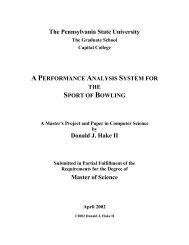k-Nearest Neighbor Classification on Spatial Data Streams Using P ...
k-Nearest Neighbor Classification on Spatial Data Streams Using P ...
k-Nearest Neighbor Classification on Spatial Data Streams Using P ...
Create successful ePaper yourself
Turn your PDF publications into a flip-book with our unique Google optimized e-Paper software.
our experiments, we find the optimal k (by trial and error method) for that particular<br />
dataset and then using the optimal k, we performed both KNN and closed-KNN and<br />
found higher accuracy for P-tree-based closed-KNN method. The experimental results<br />
are given in secti<strong>on</strong> 4. In our P-tree implementati<strong>on</strong>, no extra computati<strong>on</strong> is required<br />
to find the closed-KNN. Our expansi<strong>on</strong> mechanism of nearest neighborhood<br />
automatically includes the points <strong>on</strong> the boundary of the neighborhood.<br />
Also, there may be more than <strong>on</strong>e class in plurality (if there is a tie in voting), in<br />
which case <strong>on</strong>e can arbitrarily chose <strong>on</strong>e of the plurality classes. Without storing the<br />
raw data we create the basic P-trees and store them for future classificati<strong>on</strong> purpose.<br />
Avoiding the examinati<strong>on</strong> of individual data points and being ready for data mining<br />
these P-trees not <strong>on</strong>ly saves classificati<strong>on</strong> time but also saves storage space, since data<br />
is stored in compressed form. This compressi<strong>on</strong> technique also increases the speed of<br />
ANDing and other operati<strong>on</strong>s <strong>on</strong> P-trees, since operati<strong>on</strong>s can be performed <strong>on</strong> the<br />
pure0 and pure1 quadrants without reference to individual bits, since all of the bits in<br />
those quadrants are the same.<br />
3.1 Expansi<strong>on</strong> of <str<strong>on</strong>g>Neighbor</str<strong>on</strong>g>hood and Distance or Similarity Metrics<br />
We begin searching for nearest neighbors by finding the exact matches. If the number<br />
of exact matches is less than k, we expand the neighborhood. The expansi<strong>on</strong> of the<br />
neighborhood in each dimensi<strong>on</strong> are d<strong>on</strong>e simultaneously, and c<strong>on</strong>tinued until the<br />
number pixels in the neighborhood is greater than or equal to k. We develop the<br />
following two different mechanisms, corresp<strong>on</strong>ding to max distance and our newly<br />
defined HOB distance, for expanding the neighborhood. They have trade offs between<br />
executi<strong>on</strong> time and classificati<strong>on</strong> accuracy.<br />
Higher Order Bit Similarity (HOBS): We propose a new similarity metric where<br />
we c<strong>on</strong>sider similarity in the most significant c<strong>on</strong>secutive bit positi<strong>on</strong>s starting from<br />
the left most bit, the highest order bit. C<strong>on</strong>sider the following two values, x 1 and y 1,<br />
represented in binary. The 1 st bit is the most significant bit and 8 th bit is the least<br />
significant bit.<br />
Bit positi<strong>on</strong>: 1 2 3 4 5 6 7 8 1 2 3 4 5 6 7 8<br />
x 1 : 0 1 1 0 1 0 0 1 x 1 : 0 1 1 0 1 0 0 1<br />
y 1 : 0 1 1 1 1 1 0 1 y 2 : 0 1 1 0 0 1 0 0<br />
These two values are similar in the three most significant bit positi<strong>on</strong>s, 1 st , 2 nd and<br />
3 rd bits (011). After they differ (4 th bit), we d<strong>on</strong>’t c<strong>on</strong>sider anymore lower order bit<br />
positi<strong>on</strong>s though x 1 and y 1 have identical bits in the 5 th , 7 th and 8 th positi<strong>on</strong>s. Since we<br />
are looking for closeness in values, after differing in some higher order bit positi<strong>on</strong>s,<br />
similarity in some lower order bit is meaningless with respect to our purpose.<br />
Similarly, x 1 and y 2 are identical in the 4 most significant bits (0110). Therefore,<br />
according to our definiti<strong>on</strong>, x 1 is closer or similar to y 2 than to y 1 .<br />
Definiti<strong>on</strong> 2. The similarity between two integers A and B is defined by<br />
HOBS(A, B) = max{s | 0 ≤ i ≤ s ⇒ a i = b i }<br />
in other words, HOBS(A, B) = s, where for all i ≤ s and 0 ≤ i, a i = b i and a s+1 ≠ b s+1 .<br />
a i and b i are the i th bits of A and B respectively.
















